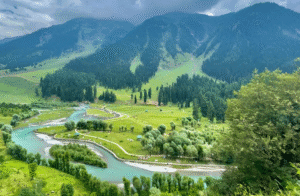Pahalgam Attack: 5 Shocking Ways It Could Destroy South Asia’s Fragile Water Peace Forever
The horrific Pahalgam terror attack, which killed 26 tourists in Kashmir, has intensified India-Pakistan tensions, prompting New Delhi to suspend the 1960 Indus Waters Treaty—a pivotal agreement that survived decades of conflict but now buckles under climate change and geopolitical strife. India’s move underscores its struggle to secure porous borders against cross-border infiltration, as militants exploit Kashmir’s rugged terrain, while Pakistan faces an existential threat: over 80% of its agriculture and critical hydropower rely on Indus River flows.
Climate change amplifies the crisis, with Himalayan glaciers feeding the basin melting at alarming rates, risking long-term water scarcity for 300 million people. Though India lacks infrastructure to abruptly halt river flows, reduced data-sharing and dry-season water management could destabilize Pakistan’s food security, fueling regional volatility. Kashmir’s marginalized communities, excluded from past water negotiations, remain caught in the crossfire, their development stifled by competing national projects.
With China controlling Tibet’s Indus headwaters and glacier dynamics rewriting hydrological rules, the region teeters on a precipice—where water scarcity, terrorism, and mistrust converge. The treaty’s collapse signals a urgent need for modernized diplomacy integrating climate science, equitable resource-sharing, and grassroots voices to prevent water from becoming a weapon in South Asia’s volatile landscape.

Pahalgam Attack: 5 Shocking Ways It Could Destroy South Asia’s Fragile Water Peace Forever
The horrific terrorist attack in Pahalgam, Jammu & Kashmir, which claimed 26 tourists’ lives, has escalated tensions between India and Pakistan to a critical juncture. Beyond immediate security concerns, India’s decision to suspend the 1960 Indus Waters Treaty (IWT)—a cornerstone of transboundary cooperation—signals a dangerous new phase in the region’s geopolitics. This move underscores how terrorism, water scarcity, and climate change are colliding to destabilize South Asia.
The Security Challenge: Infiltration and the Himalayan Labyrinth
The attack’s perpetrators, suspected to be foreign militants, vanished into the dense Pir Panjal jungles—a terrain so rugged that even advanced military tech struggles to track movement. This highlights India’s Achilles’ heel: a porous border. Despite fencing 90% of the 1,000-km India-Pakistan frontier in Kashmir, gaps persist. Riverine sections, snowfall damage, and outdated surveillance tech leave vulnerabilities.
- Infiltration vs. Counter-Terrorism: Hunting militants in Kashmir’s jungles has cost over 50 soldiers’ lives since 2020. Pakistan-based groups now deploy “ghost terrorists” who avoid local contact, complicating intelligence efforts.
- The Border Grid Fix: India’s delayed Comprehensive Integrated Border Management System (CIBMS), aimed at tech-driven surveillance, remains incomplete. Solutions like thermal sensors and drone patrols are urgent but face logistical hurdles, from harsh winters to power shortages.
As one security expert noted: “Stopping terrorists at the border is far easier than hunting them in Kashmir’s forests. But without modern infrastructure and round-the-clock vigilance, the grid remains leaky.”
Water as a Weapon: The Indus Treaty’s Precarious Future
The IWT’s suspension marks a tectonic shift. The treaty survived three wars but is buckling under climate change, population growth, and political distrust.
- The Climate Wildcard: Himalayan glaciers feeding the Indus are melting at alarming rates—losing 8 billion tons of ice annually. While this temporarily boosts river flows, long-term scarcity looms. By 2100, glacier loss could reduce Indus flows by 50%, threatening 300 million people’s survival.
- Pakistan’s Lifeline at Risk: Pakistan relies on the Indus for 80% of its agriculture and 33% of hydropower. India’s upstream dams (like Kishanganga and Ratle) already strain relations; suspending data-sharing on river flows could cripple Pakistan’s flood preparedness and irrigation planning.
Yet experts caution that India’s capacity to “turn off the tap” is limited. Most projects on western rivers (Indus, Jhelum, Chenab) are run-of-the-river hydropower dams with minimal storage. Diverting massive flows would require infrastructure India lacks. “It’s a myth that India can starve Pakistan overnight,” says water analyst Himanshu Thakkar. “But during dry seasons, even small reductions could spark crises.”
Kashmir: The Unresolved Fault Line
Kashmir’s status remains central to the conflict. The IWT excluded Kashmiri voices, leaving the region’s hydropower potential untapped and its people marginalized.
- Local Grievances: Despite abundant water, Kashmir utilizes only 20% of its hydropower capacity. Projects like the Dulhasti Dam prioritize Indian energy needs over local development, fueling resentment.
- China’s Shadow: As India-Pakistan tensions rise, China’s control over Tibet’s Indus headwaters adds complexity. In 2016, China temporarily blocked a Brahmaputra tributary, signaling its capacity to leverage water against downstream India.
The Path Ahead: Climate, Diplomacy, or War?
The treaty’s suspension risks a vicious cycle:
- Humanitarian Fallout: Reduced water-sharing could devastate Pakistan’s agriculture, displacing millions and worsening food insecurity.
- Environmental Tipping Points: Glacier melt and erratic monsoons demand updated treaties incorporating climate data—a gap the IWT never addressed.
- Proxy Wars: Militant groups could exploit water-driven instability, perpetuating violence in Kashmir.
Diplomatic Solutions:
- Modernize the IWT: Include groundwater management, climate adaptation, and Kashmir’s representation.
- Third-Party Mediation: The World Bank, which brokered the original treaty, could revive dialogue with scientific backing.
- Track-II Diplomacy: Engage civil society and environmentalists to build trust beyond politics.
Conclusion: A Region at the Crossroads
The Pahalgam attack has exposed how intertwined terrorism, water, and climate are in South Asia. India’s border security woes and Pakistan’s water insecurity are two sides of the same coin—a coin increasingly eroded by mistrust and ecological collapse. Without urgent cooperation, the region risks spiraling into conflict where water becomes both a casualty and a weapon. As glaciers retreat and tensions rise, the Indus Basin’s future hinges on whether old rivals can prioritize survival over strife.
You must be logged in to post a comment.